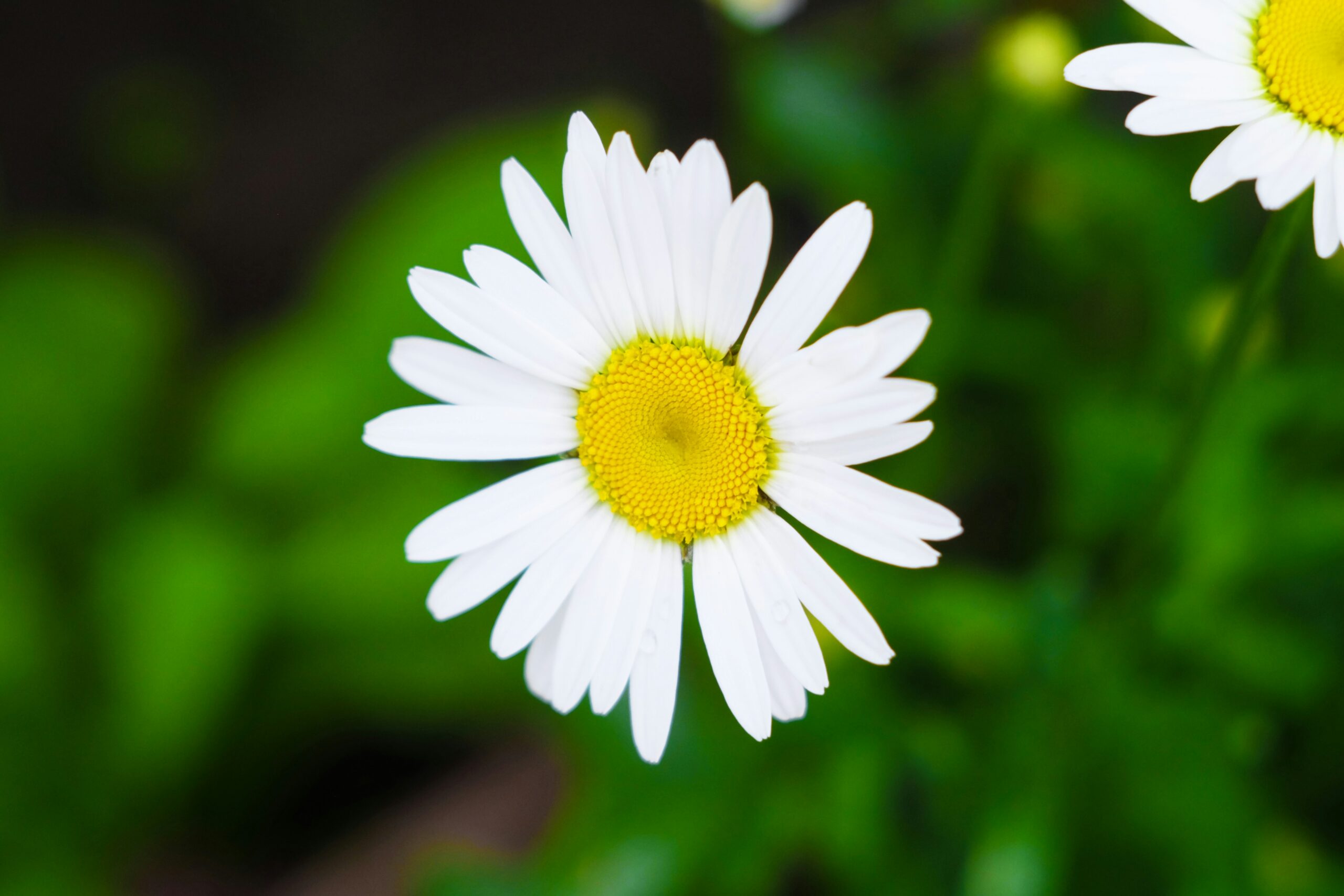One of the most well-known plants is chamomile. Cultured camomile is primarily used in Medicine and Cosmetology. Many diseases can be treated with chamomile because it is a naturally health-promoting herb. It is applied both orally and on the external body.
Everyone has heard of camomile tea, but that is far from the only form it takes. One thing you will notice about chamomile is that it has quite a strong aroma.
Chamomile is a tiny plant belonging to the Asteraceae family. It is a common annual plant in Europe, Asia, and North Africa. It is recognizable by its pretty white flowers. Once dried, the plant is an ingredient in many medicinal potions. That is why they possess many substances seldom found in other plants.

Its functions include sedative, decongestant, and anti-inflammatory effects. It is also used in the cosmetic industry for different products. Its cosmetic content cleanses and soothes irritation.
However, chamomile is contraindicated for some people because it can have side effects. It can cause an allergic reaction to camomile; those prone to allergies should not use this plant daily. Chamomile products should be used as indicated by the manufacturer and recommended by your health care provider. Learn more about camomile and its excellent benefits.
Chamomile has many varieties, which are identified by first appearing to be different. The most commonly known camomile is Matricaria chamomilla![]() , which doctors often use as its scientific name. A pharmacologically rich herb with numerous bioactive compounds, it is a plant that can be encountered and used worldwide. Large manufacturers include Hungary
, which doctors often use as its scientific name. A pharmacologically rich herb with numerous bioactive compounds, it is a plant that can be encountered and used worldwide. Large manufacturers include Hungary![]() and other EU nations.
and other EU nations.
Chamomile has been popular in natural medicine for centuries due to its health-promoting properties. In addition to being used as a spice in the 2000s, this same herb has been put into dietary supplements. This is commonly known as a nutraceutical that helps to support human health. The positive contribution of natural means to prevent diseases In this way, the health benefits of camomile can help in these aspects:

It can be an analgesic and has a calming effect on the digestive system. Intended effects are realized because of the active substance contained in the plant. In patients, analgesic effects were observed following the administration of a low camomile dose, consistent with its pharmacological activity. Chamomile is excellent for many types of pain as an analgesic. It can relieve headaches, toothache, and muscle aches. Chamomile tea can be used in menstruation cramps![]() , too. The herb is well known for its use in alleviating pain.
, too. The herb is well known for its use in alleviating pain.
Chamomile can be beneficial in decreasing allergic symptoms. This plant contains antioxidants that prevent allergic processes and reduce histamine levels![]() in the body. Chamomile oil can also help when applied locally. For example, application to a patient's skin with allergic inflammation led to symptomatic relief. The same camomile compresses well to soothe inflammation of the mucous membranes of the eyes, often accompanied by inhalant allergies. One of the substances found in camomile has anti-allergy effects, and a brew prepared from this plant can thus reduce annoying allergy symptoms. On the other hand, camomile can cause allergies in some people and will only exacerbate allergy symptoms instead of having a beneficial effect.
in the body. Chamomile oil can also help when applied locally. For example, application to a patient's skin with allergic inflammation led to symptomatic relief. The same camomile compresses well to soothe inflammation of the mucous membranes of the eyes, often accompanied by inhalant allergies. One of the substances found in camomile has anti-allergy effects, and a brew prepared from this plant can thus reduce annoying allergy symptoms. On the other hand, camomile can cause allergies in some people and will only exacerbate allergy symptoms instead of having a beneficial effect.
Scientists have found that several types of camomile (Matricaria recutita) lead to apoptosis-signaling in some cancer cells. Chamomile significantly affects human cancer cells, inhibiting their viability. It can also be attributed to camomile's uptake of free radicals and the reduction in chronic inflammation throughout the body. Chamomile's constituents, therefore, demonstrate anti-cancer activity. The plant shows promise for breast, skin, and lung cancer diseases. Additional research in this area is required; however, the activity of camomile alone cannot cure cancer. However, it is worth using natural sources to minimize cancer risk.

The antihypertensive effect of camomile extracts can decrease the risk of heart disease. The herb lowers blood pressure dramatically! Chamomile is superior to even an antihypertensive. Moreover, amelioration in oxidative stress and inflammation could be the potential therapeutic targets to safeguard patients from myocardial hypertrophy. Various studies have suggested that this plant is efficacious in patients with high mortality from coronary heart disease![]() . Not only does camomile belong to the herb class, but it is also a dependable friend of our heart.
. Not only does camomile belong to the herb class, but it is also a dependable friend of our heart.
It heals inflammations in the body. Injuries or infections cause many diseases and conditions, so the anti-inflammatory effect of chamomile extract is beneficial. Studies have reported that topical application of camomile can help reduce skin inflammation. These are the substances found in camomile that give it its anti-inflammatory effect and can reach deep into your skin. Another relatively common use is camomile extracts for inflammation related to irritable bowel syndrome![]() . A camomile infusion will also help treat the abdominal cramps and diarrhea of this pathology.
. A camomile infusion will also help treat the abdominal cramps and diarrhea of this pathology.
Data on camomile are provided to have antimicrobial properties. The findings revealed it has anti-inflammatory, antioxidant, and analgesic effects and activity against several strains of bacteria that cause infection, which was proven by wound healing in a group treated with camomile ointment. Besides, camomile has a unique trait of creating bacterial biofilms, and what it does is interfere with the resistance of these pathogens. Chamomile is an antimicrobial that can be utilized on organisms like Escherichia coli![]() . Chamomile also decreases Candida albicans
. Chamomile also decreases Candida albicans![]() infections, showing antifungal effects. Best of all, chamomile's antiviral action extends to Herpes simplex
infections, showing antifungal effects. Best of all, chamomile's antiviral action extends to Herpes simplex![]() virus and COVID-19
virus and COVID-19![]() . So, to reduce the chances of getting microbial infections by all means, use the power of herbs.
. So, to reduce the chances of getting microbial infections by all means, use the power of herbs.
It is thanks to its antioxidant action that camomile inhibits the overproduction of free radicals. Research shows that the chamomile herb can be anti-genotoxic, protecting our cells, proteins, and lipids against damage. It also diminishes the action of inflammatory mediators. Chamomile has antioxidant properties that have been substantiated by research and boosts cancer treatment's efficacy.

For example, it affects the central nervous system and can help reduce stress due to camomile. Chamomile tea — This herbal infusion is well-known for its calming agents. Also, chamomile has a calming effect on sleep. Some newer studies suggest camomile can help with anxiety (indirectly related to its impact on place it under skin levels). Chamomile can also mimic neurotransmitter activity, which influences serotonin levels — thus, the potential for alleviating depression. Based on its active ingredients, chamomile also emerged as a potentially crucial compound in treating epilepsy![]() and Alzheimer's
and Alzheimer's![]() .
.
Chamomile constituents, which are natural antioxidants, make it crucial to curing metabolic disorders like obesity. Chamomile can also be helpful for individuals with diabetes-type fasting sugar values unless it is abnormal (moderate anti-hyperglycemic properties). Moreover, camomile exerts a hepatoprotective effect![]() , i.e., it prevents aftereffects of harmful substances on the liver. So, the characteristic of protection in camomile allows us to be protected against many problems.
, i.e., it prevents aftereffects of harmful substances on the liver. So, the characteristic of protection in camomile allows us to be protected against many problems.
The camomile plant has several active compounds that benefit human health. Fresh or dried chamomile flowers provide the ingredients; hence, essential oils and infusions are used to take advantage of chamomiles' health properties. Components in camomile:

This is one of the more than one hundred ingredients camomile has. Researchers have identified the essential constituents that are responsible for its healing effect. The ingredient values may differ depending on the brand and form of camomile used or due to the species of plant used as well as cultivar and cultivation practices. One of the fundamental constituents of this herb is apigenin![]() . This powerful bioactive is believed to be responsible for most of the properties attributed to chamomile. Most of the chamomile is vitamin C, and the minerals identified in it are potassium and manganese. The healing properties of camomile are deservedly popular in the medicinal and cosmetic industry.
. This powerful bioactive is believed to be responsible for most of the properties attributed to chamomile. Most of the chamomile is vitamin C, and the minerals identified in it are potassium and manganese. The healing properties of camomile are deservedly popular in the medicinal and cosmetic industry.
Chamomile is a plant with a relatively mild safety profile. Nevertheless, some people may be allergic to herbs/medicinal plants in general, so it is necessary to exercise particular caution when using chamomile and other natural forms of treatment. You should see your doctor before adding camomile to a treatment. Examples of contraindications for chamomile are:

An allergy is a crucial contraindication to applying chamomile. Note: Although camomile is generally recognized as safe, some patients have a ragweed allergy, so you may want to avoid this group. Those with allergies to plants such as chrysanthemums![]() and ragweed
and ragweed![]() may have more potential for camomile allergic reactions. Pin contact allergy to topical chamomile is conceivable. This is typical of a skin allergy reaction. Also, the eyes may become irritated due to inflammation caused by camomile application in this zone. This is the reason why testing for allergies should be done before you ever consume camomile.
may have more potential for camomile allergic reactions. Pin contact allergy to topical chamomile is conceivable. This is typical of a skin allergy reaction. Also, the eyes may become irritated due to inflammation caused by camomile application in this zone. This is the reason why testing for allergies should be done before you ever consume camomile.
However, experts caution pregnant women about using camomile. This includes individuals who have to be cautious about using any herbal product. Chamomile has been used since ancient times by pregnant women to get rid of all manner of malaise, ranging from discomfort in the digestive system to stretch marks. However, in a few studies, pregnant women who consumed camomile were more likely to experience miscarriages![]() and preterm births
and preterm births![]() . In a pregnant woman, regular consumption of chamomile may result in the development of the heart of a child. So, it is better to consult a doctor first regarding the fear of eating chamomile during pregnancy because this plant can be harmful.
. In a pregnant woman, regular consumption of chamomile may result in the development of the heart of a child. So, it is better to consult a doctor first regarding the fear of eating chamomile during pregnancy because this plant can be harmful.
Certain herbs should not be mixed with medications because they are far too active in the body and will compete with the processes that need to occur in place. Inoccur camomile should not be used together with the treatment. It concerns anticoagulants. Chamomile and the action of the said drugs may increase bleeding. As a central nervous system depressant, camomile may potentiate the effects of sedatives and other medications that affect mental alertness (such as sleeping pills, anti-anxiety drugs, anticonvulsants, or antidepressants), increasing their side effects. Remember to always talk to your doctor when taking herbal supplementation medication.

Chamomile does not tend to have side effects, but they are possible—especially if you use excessive quantities of the herb. The following is a list of patient side effects recorded during special reports.
Chamomile, however, has produced some digestive issues in specific individuals, including nausea and vomiting. The other serious side effect is that patients may notice loose stools along with it. Long-term use of camomile can also result in indigestion and a more unpleasant taste, outweighing the small benefits of chamomiles.
Chamomile, although it acts as a painkiller in certain situations and to a limited extent, can also present a painful phenomenon in patients experiencing headaches and dizziness. If the consumption of camomile infusion becomes excessive, it can irritate the nervous system, and others may even have hypersensitivity to substances present in it that cause symptoms.
Chamomile lowers blood pressure. For this reason, camomile can reduce blood pressure too much in people with low blood pressure. If blood pressure is very low, then one can feel fatigue. Chamomile chemicals, once again the flavonoids released, act on and cause sleep receptors, in addition to existing behind lethargy.
Now, Chamomile (Matricaria chamomilla) is a plant almost naturalized worldwide. It is widespread across Europe, Asia, and North America, and it also occurs in northern Africa—a medicine whose benefits have been discovered by human beings thousands of years ago. Wild camomile flowers throughout the year said that May fall blooming from showing up in this period—green leaves, green and innocent. The flowers are cropped out once the flowering starts to occur, dried, and then used in many medicine toggles. All of this results from the value of substances not otherwise found in nearly any other plant. Chamomile also has many health benefits and is used to cure different ailments.
Additionally, it is administered topically and orally, such as in rinses or compresses. Chamomile contains calming medicinal substances in its composition: essential oil, flavonoids, organic acids (acetic and formic), choline made of vitamin C — ascorbic acid, and also manganese potassium. It should be used with caution during pregnancy, and consult your healthcare practitioner if you would like to take it during this time. The use of herbs with a wide variety of drugs must be avoided. Chamomile, however, comes with a word of caution — it should be limited in intake because you may experience allergic reactions and side effects.